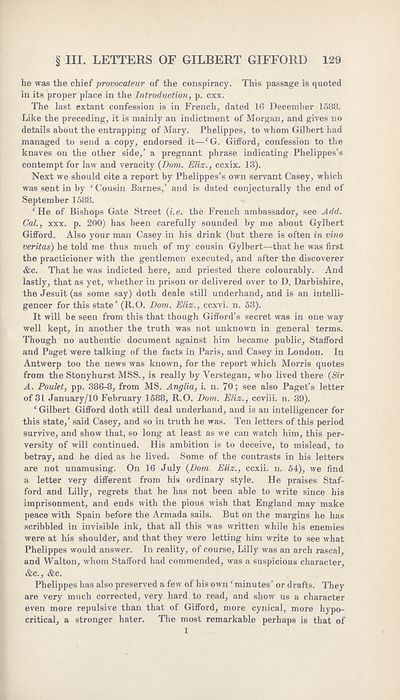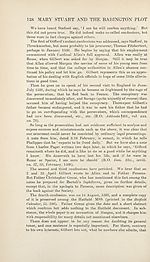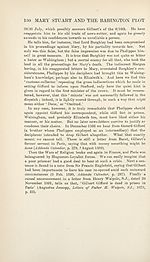Series 3 > Mary Queen of Scots and the Babington plot
(346) Page 129
Download files
Complete book:
Individual page:
Thumbnail gallery: Grid view | List view

§ III. LETTERS OF GILBERT GIFFORD 129
he was the chief provocateur of the conspiracy. This passage is quoted
in its proper place in the Introduction, p. cxx.
The last extant confession is in French, dated 16 December 1588.
Like the preceding, it is mainly an indictment of Morgan, and gives no
details about the entrapping of Mary. Phelippes, to whom Gilbert had
managed to send a copy, endorsed it—CG. Gifford, confession to the
knaves on the other side,’ a pregnant phrase indicating Phelippes’s
contempt for law and veracity {Bom. Eliz., ccxix. 13).
Next we should cite a report by Phelippes’s own servant Casey, which
was sent in by ‘ Cousin Barnes,’ and is dated conjecturally the end of
September 1588.
‘He of Bishops Gate Street (i.e. the French ambassador, see Add.
Gal., xxx. p. 200) has been carefully sounded by me about Gylbert
Gifford. Also your man Casey in his drink (but there is often in vino
veritas) he told me thus much of my cousin Gylbert—that he was first
the practicioner with the gentlemen executed, and after the discoverer
&c. That he was indicted here, and priested there colourably. And
lastly, that as yet, whether in prison or delivered over to D. Darbishire,
the Jesuit (as some say) doth deale still underhand, and is an intelli¬
gencer for this state’ (R.O. Bom. Eliz., ccxvi. n. 53).
It will be seen from this that though Gifford’s secret was in one way
well kept, in another the truth was not unknown in general terms.
Though no authentic document against him became public, Stafford
and Paget were talking of the facts in Paris, and Casey in London. In
Antwerp too the news was known, for the report which Morris quotes
from the Stonyhurst MSS., is really by Verstegan, who lived there {Sir
A. Poulet, pp. 386-8, from MS. Anglia, i. n. 70; see also Paget’s letter
of 31 January/10 February 1588, R.O. Bom. Eliz., ccviii. n. 39).
f Gilbert Gifford doth still deal underhand, and is an intelligencer for
this state,’ said Casey, and so in truth he was. Ten letters of this period
survive, and show that, so long at least as we can watch him, this per¬
versity of will continued. His ambition is to deceive, to mislead, to
betray, and he died as he lived. Some of the contrasts in his letters
are not unamusing. On 16 July {Bom, Eliz., ccxii. n. 54), we find
a letter very different from his ordinary style. He praises Staf¬
ford and Lilly, regrets that he has not been able to write since his
imprisonment, and ends with the pious wish that England may make
peace with Spain before the Armada sails. But on the margins he has
scribbled in invisible ink, that all this was written while his enemies
were at his shoulder, and that they were letting him write to see what
Phelippes would answer. In reality, of course, Lilly was an arch rascal,
and Walton, whom Stafford had commended, was a suspicious character,
&c., &c.
Phelippes has also preserved a few of his own ‘minutes’ or drafts. They
are very much corrected, very hard to read, and show us a character
even more repulsive than that of Gifford, more cynical, more hypo¬
critical, a stronger hater. The most remarkable perhaps is that of
he was the chief provocateur of the conspiracy. This passage is quoted
in its proper place in the Introduction, p. cxx.
The last extant confession is in French, dated 16 December 1588.
Like the preceding, it is mainly an indictment of Morgan, and gives no
details about the entrapping of Mary. Phelippes, to whom Gilbert had
managed to send a copy, endorsed it—CG. Gifford, confession to the
knaves on the other side,’ a pregnant phrase indicating Phelippes’s
contempt for law and veracity {Bom. Eliz., ccxix. 13).
Next we should cite a report by Phelippes’s own servant Casey, which
was sent in by ‘ Cousin Barnes,’ and is dated conjecturally the end of
September 1588.
‘He of Bishops Gate Street (i.e. the French ambassador, see Add.
Gal., xxx. p. 200) has been carefully sounded by me about Gylbert
Gifford. Also your man Casey in his drink (but there is often in vino
veritas) he told me thus much of my cousin Gylbert—that he was first
the practicioner with the gentlemen executed, and after the discoverer
&c. That he was indicted here, and priested there colourably. And
lastly, that as yet, whether in prison or delivered over to D. Darbishire,
the Jesuit (as some say) doth deale still underhand, and is an intelli¬
gencer for this state’ (R.O. Bom. Eliz., ccxvi. n. 53).
It will be seen from this that though Gifford’s secret was in one way
well kept, in another the truth was not unknown in general terms.
Though no authentic document against him became public, Stafford
and Paget were talking of the facts in Paris, and Casey in London. In
Antwerp too the news was known, for the report which Morris quotes
from the Stonyhurst MSS., is really by Verstegan, who lived there {Sir
A. Poulet, pp. 386-8, from MS. Anglia, i. n. 70; see also Paget’s letter
of 31 January/10 February 1588, R.O. Bom. Eliz., ccviii. n. 39).
f Gilbert Gifford doth still deal underhand, and is an intelligencer for
this state,’ said Casey, and so in truth he was. Ten letters of this period
survive, and show that, so long at least as we can watch him, this per¬
versity of will continued. His ambition is to deceive, to mislead, to
betray, and he died as he lived. Some of the contrasts in his letters
are not unamusing. On 16 July {Bom, Eliz., ccxii. n. 54), we find
a letter very different from his ordinary style. He praises Staf¬
ford and Lilly, regrets that he has not been able to write since his
imprisonment, and ends with the pious wish that England may make
peace with Spain before the Armada sails. But on the margins he has
scribbled in invisible ink, that all this was written while his enemies
were at his shoulder, and that they were letting him write to see what
Phelippes would answer. In reality, of course, Lilly was an arch rascal,
and Walton, whom Stafford had commended, was a suspicious character,
&c., &c.
Phelippes has also preserved a few of his own ‘minutes’ or drafts. They
are very much corrected, very hard to read, and show us a character
even more repulsive than that of Gifford, more cynical, more hypo¬
critical, a stronger hater. The most remarkable perhaps is that of
Set display mode to:
![]() Universal Viewer |
Universal Viewer | ![]() Mirador |
Large image | Transcription
Mirador |
Large image | Transcription
Images and transcriptions on this page, including medium image downloads, may be used under the Creative Commons Attribution 4.0 International Licence unless otherwise stated. ![]()
| Scottish History Society volumes > Series 3 > Mary Queen of Scots and the Babington plot > (346) Page 129 |
|---|
| Permanent URL | https://digital.nls.uk/127238193 |
|---|
| Attribution and copyright: |
|
|---|
| Description | Over 180 volumes, published by the Scottish History Society, containing original sources on Scotland's history and people. With a wide range of subjects, the books collectively cover all periods from the 12th to 20th centuries, and reflect changing trends in Scottish history. Sources are accompanied by scholarly interpretation, references and bibliographies. Volumes are usually published annually, and more digitised volumes will be added as they become available. |
|---|


